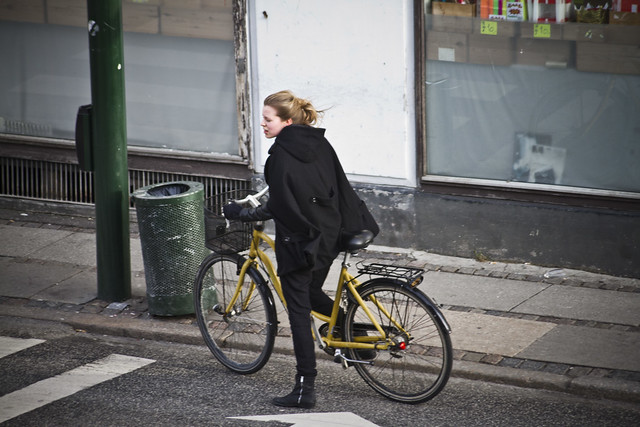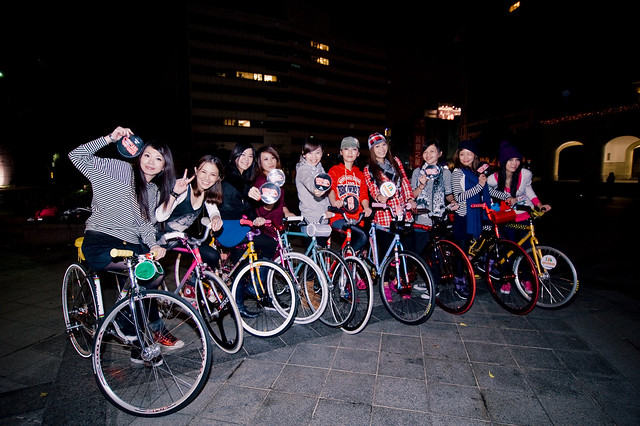Es sobre la movida de las bicicletas en Amsterdam. Para los que no saben, Amsterdam es una ciudad donde hasta el más millonario anda en bicicleta. Un amigo que vive ahí y trabaja en Tom Tom me ha llegado a contar que muy a menudo ve al presidente de la empresa en su bici. También su jefa, que es una persona muy potentada del reino unido, suele ir en su bici al trabajo, y no solo en los preciosos días soleados de verano, sino que tmb en el invierno y con lluvia!
Bueno, por todas estas cosas, me pareció increíble este artículo escrito en forma de carta a una tía por Aaf Brandt Corstius. Acá va.

Dear Aunt Li,
Yesterday, with my son in the bakfiets, I cycled past the playground and a group of tourists took a picture of us.
It made me think of you. Maybe you’ll also take lots of pictures of us, when we’re showing you the sights.
But first, I need to tell you a thing or two about the bakfiets. Maybe I need to tell you something about cycling in general before you come to Amsterdam. Because, Aunt Li, bikes in Amsterdam are just like yellow cabs in New York, rickshaws in Jakarta, scooters in Bangkok and snowmobiles (so I imagine) in Alberta, Canada — they are everywhere, they are fast and they are slightly dangerous.
But once you’ve read this letter, you’ll be OK. Amsterdammers ride bikes because the streets are narrow, the country is flat, and the parking fees are high. So bikes are a good solution. All Amsterdammers have the same type of bike: an old, rusty one. It won’t get stolen, isn’t afraid of rain and has no luxury gimmicks like lights, brakes, gears or a bell.
The Amsterdammer will simply shout "Tring!" when he wants to pass. There’s your first Dutch word, Aunt Li, and it’s the most important one. Another variation is "Tring, Tring!". Then you really have to dive out of the way quickly, because you’re probably walking in a bicycle lane.
This gives an important clue about the nature of the Amsterdammer. He is someone who, if he wants to pass, will bellow "Tring!" himself. A practical, assertive and rather pronounced creature.
The most practical and assertive of Amsterdammers — the mothers — have taken to bakfietsen; gigantic bikes with a wooden barrow. Where in other countries bananas, fridges and live chickens are transported on such bikes, Amsterdam mothers use them for their children.
Often they decorate their bakfiets with flowers and brightly coloured crates. But you need to be wary of these cute-looking fairytale bikes; they go just as fast as all the rest, but are much heavier, have a braking distance of half a kilometre, and the mothers are often in a hurry.
So, be careful. That’s the transport covered. And the people. But there’s a little more to be said about them.
Amsterdammers are in many ways the same as residents of other (mini) metropolises; they rush about hurriedly, talk quickly, are absorbed by their mobile phones and like to complain about their city. The standard complaint of Amsterdammers these days is that there are too many potholes in the streets, due to a baffing mega-project that’s grown slightly out of hand: a new metro line to connect north and south Amsterdam. In this, people here are just like the inhabitants of Sydney, Boston or Shanghai. They enjoy a good whine, preferably about logistical problems.
But there is also something special about Amsterdammers. According to Rotterdammers, (Rotterdam being the more or less adjoining mini-metropolis that both Amsterdammers and Rotterdammers agree is completely different), the Amsterdammer never works. (Rotterdammers however, are always working; very hard. That’s because of their industrious, port-city mentality.)
This of course is not true, but Amsterdammers really are very fond of their free time. Every day, including weekdays, you will find them on the streets, in the shops, in parks, on terraces and in cafes. They can spend hours in a cafe, because the great thing about Amsterdam cafe culture is that you will not be sent away quickly. You are welcome to spend a few hours hanging around with a newspaper, your iPhone and a single cup of coffee without anyone asking if you are done, or bringing you the bill.
They also are not quick to ask if you want another drink; you have to arrange that yourself, again requiring an assertive attitude, a wide array of expressive hand signals, dramatic winks, lengthy stints of eye contact and a little coercion.
An advantage of Amsterdam waiters and waitresses is that, unlike in other global capitals, the tipping system isn’t set in stone. They are happy with a left over euro, a trait that speaks in their favour.
They are also all fluent in English, just like most Amsterdammers, but still find it very charming when a tourist can muster a heavily accented "Dank u wel," (pronounced phonetically: "Dohnk-eu-vel"). It means ‘thanks.’
Should you take note of everything that Amsterdammers eat and drink in the hours they spend lounging in restaurants and cafes, Aunt Li, you might be slightly mystified.
There’s mint tea, currently the favourite drink; a mug of hot water containing a substantial forest of fresh mint. Amsterdammers have adopted this from their Moroccan neighbours, except they add considerably less sugar. So, it’s just water. With mint.
A Calvinist drink.
On an Amsterdammer’s plate, be it lunchtime or around dinnertime, you can often find a brown, fried, oblong object covered with breadcrumbs. I have witnessed many foreign friends encounter these with a look of surprise and barely concealed revulsion, but they really are delicious. They are called kroketten: deep-fried meat stew in a crispy crust. I know, it still doesn’t sound good, but it is.
When the Amsterdammer has a drink — a popular pastime — he eats a small, round version of the same snack. Then, they’re called bitterballen: a good introduction to Dutch cuisine, which is rather basic. But tasty. Just so you know.
So that’s the people covered. What they do, how they move, what they eat and drink. When it comes to animals, Amsterdam is populated by cats and pigeons. Almost every Amsterdammer has one or two cats, preferably of the old and fat variety, which gaze cynically out of the window.
Less photogenic is the Amsterdam pigeon. They’re true urban pigeons, often quite plump and with only one leg. They laze around all over Amsterdam. Amazingly, they still haven’t learned the word ‘Tring!’, and so, often walk right in front of cyclists. That’s why Amsterdammers have surprisingly little affection for pigeons, and call them flying rats.
Luckily, tourists don’t know how annoying pigeons can be and — as in other tourist places where pigeons congregate, such as Venice — they engage in pigeon worship. On the Dam — a hotspot for pigeons, but also for tourists, living statues and hotdog vendors — multitudes of visitors feed the pigeons every day and take romantic pictures of flocks of them swooping up in their thousands and returning to the ground again amid furious flapping.
And now that we’re on the topic of places where tourists like to convene, Aunt Li, one more thing. Naturally you will want to see the Anne Frank House. So you should. But go in the evening, with tickets that you’ve printed out online. Because then the hordes of tourists are somewhere else. The same goes for the Van Gogh Museum. You can go there on Fridays until ten o’clock.
A canal cruise: of course that’s another thing that you’d like to do, and there’s nothing wrong with that, because even after living in this city for thirty years, I still like canal cruises. Not so much because of doubtful attractions like ‘the narrowest house in Amsterdam’, but for the chance to peer inside the hundreds of house boats along the canals. Prime real estate by the way, even in times of recession. And naturally, you have to drop by the Red Light District; that’s simply part of your duty as a tourist — but while you’re there, stop offfor a bite of Chinese, Thai or Vietnamese food, and check out the Buddhist temple on Zeedijk.
Actually, when you’re here, you can easily take in the whole city, because Amsterdam is really a small, straightforward place. At first, it might seem like a dizzying vortex with all its whirling canals, bikes, pigeons, cats and gentle chaos. But Amsterdam is essentially still a charming, old Dutch town with a smattering of international influences such as Turkish vegetable stores, Surinamese restaurants, Indonesian mini-marts and Moroccan croissant shops.
To illustrate — I live in a remote corner of Amsterdam, in Watergraafsmeer, an attractive area where many thirtysomethings with children reside. In the 19th century, the countryside started here, and these were pastures with grazing cows. Amsterdammers still act as if that’s the case. "You live in Watergraafsmeer? Then I’m afraid that I can never come to visit. It’s too far away." Amsterdammers consider anything beyond a ten-minute-cycle-ride from the Dam as the suburbs, the countryside, or actually, the outback. And my neighbourhood is fifteen minutes away from the Dam by bike.
That sums up Amsterdam: almost nothing is further away than a fifteen minute cycle. And that sums up Amsterdammers: anything further than ten minutes by bike is too far. They are dear, lovely villagers on old, fast bikes. ‘Tring!,’ Aunt Li. Remember that word. Then everything will be just fine.
With love, Aaf.
Aaf Brandt Corstius is a prolific commentator for De Volkskrant and several other Dutch newspapers and magazines.
Fuente

